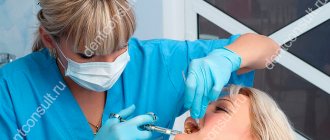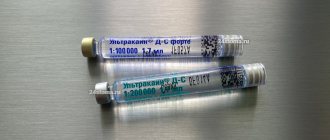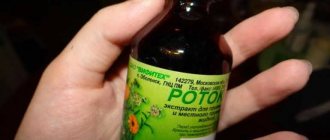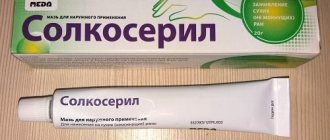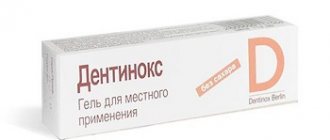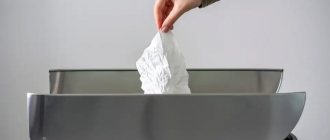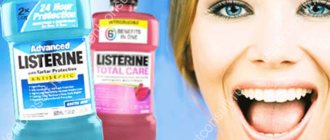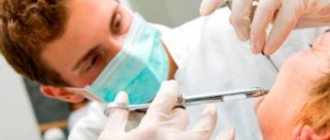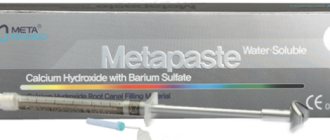Pharmacodynamics and pharmacokinetics
Articaine is a thiophene and has a local anesthetic effect. Used for conduction and infiltration anesthesia . Articaine undergoes hydrolysis in a slightly alkaline environment of tissues with the release of a base that has lipophilic properties, and therefore easily penetrates through the cell membrane into the nerve fiber.
By influencing receptors, it blocks the delivery of sodium ions into the cell and the conduction of impulses along nerve fibers. The effect of the drug is observed immediately after its administration and lasts from 1 to 3 hours. Efficiency is reduced in acidic environments.
When administered intramuscularly, Cmax is achieved within 20 to 40 minutes.
When introduced under the mucous membrane of the oral cavity, it exhibits high diffusion ability.
95% bound to plasma proteins.
Metabolized in the liver, T½ is approximately 60 – 80 minutes.
Within 6 hours, 54 - 63% is excreted by the kidneys.
Can penetrate the placental barrier (to a lesser extent than other local anesthetics); it penetrates the blood-brain barrier in small quantities. It is practically not excreted in breast milk.
pharmachologic effect
The mechanism is based on the effect on the endings of both sensory nerves and nerve fibers, which creates conditions for disrupting the generation of an exciting impulse and its conduction to other structures. Articaine interacts with receptors that are responsible for the functioning of sodium channels. By influencing them, the flow of sodium ions through them is blocked, as a result of which an anesthetic effect develops.
The duration of action is about 20 minutes. It is destroyed into products that are non-toxic to the body, which makes it possible to re-introduce the substance. In an acidic environment, the effectiveness of the drug decreases.
Contraindications
- children under 4 years of age;
- increased sensitivity to local anesthetics of the amide group;
- paroxysmal tachycardia;
- B12 deficiency anemia (megaloblastic);
- angle-closure glaucoma;
- atrial fibrillation;
- bronchial asthma;
- chronic hypoxia.
Prescribe with caution:
- for pathologies of the central nervous system;
- with pseudocholinesterase deficiency;
- with pernicious anemia;
- with hypoxia.
Reviews from dentists about the drug Articaine
Most practicing dentists consider Articaine to be the best representative of local anesthetics due to its high effectiveness. At the same time, when using the medication, there is a low incidence of allergic reactions, the possibility of safe use in pregnant women, and the absence of addiction. The only small drawback of Articaine, according to experts, is the inability to prescribe it to children under 4 years of age. In all other cases, Articaine is rightly called one of the drugs of choice.
This information is intended for medical professionals and specialists.
Side effects
Peripheral and central nervous system:
- headache;
- dyspnea;
- visual impairment;
- apnea;
- muscle twitching;
- tremor;
- convulsions;
- diplopia;
- disturbance of consciousness.
The cardiovascular system:
- bradycardia;
- tachycardia;
- decrease in blood pressure.
Digestive system:
- nausea;
- diarrhea;
- vomit.
Allergic manifestations:
- itching;
- skin rash;
- angioedema;
- very rarely - anaphylactic shock.
Articaine: side effects
Such qualities of Artican as low fat solubility, high% binding to blood proteins, low half-life ensure low toxicity of the drug. However, depending on the general condition, age, individual reactions of the patient and his existing systemic diseases, side effects may be observed during anesthesia with the drug, such as:
- disturbance or confusion;
- vertigo;
- headache;
- nausea;
- dyspnea;
- decreased blood pressure;
- diplopia;
- muscle tremors;
- allergic and local reactions, manifested in symptoms of urticaria, conjunctivitis, rhinitis, skin hyperemia, swelling and inflammation at the injection site.
Articaine should be used with caution during dental procedures in patients with impaired cardiovascular function, vascular diseases, liver and kidney failure.
Instructions for use of Articaine (Method and dosage)
The instructions for Articaine in dentistry suggest an individual dosage regimen, depending on the severity of the procedure, the time of its implementation and the patient’s tolerability of the drug.
The maximum single dose of the drug is 6 mg per kilogram of body weight.
To carry out surgical intervention, which requires more time than Articaine can provide, a combination drug is used - Articaine Inibsa Epinephrine as active ingredients . Epinephrine exhibits a vasoconstrictor effect at the site of drug administration, thereby increasing its absorption time, prolonging its effect.
Instructions for use of the drug Articaine Epinephrine in dentistry recommend the following doses of the drug.
During the procedure for removing teeth of the upper jaw without complications and inflammation - 1.7 ml of the drug per tooth, if ineffective, another 1 ml - 1.7 ml.
For a palatal incision or suture - 0.1 ml.
When grinding teeth to install crowns or prepare cavities, a vestibular injection is given in a dose of 0.5 ml - 1.7 ml for each tooth.
During the procedure for removing premolars of the lower jaw without complications, infiltration anesthesia , which acts as a conduction anesthesia.
The maximum dose in dentistry for adult patients is 7 mg per kilogram of weight. For pediatric patients over 4 years of age - 5 mg per kilogram of body weight.
The drug is intended for use in the oral cavity.
In order to avoid accidental release of the drug into the blood vessels, a two-stage aspiration test should always be performed before its administration, rotating the needle 90 and 180°. The main systemic reactions that may develop as a result of accidental intravascular administration of the drug can be avoided by following the injection technique: after an aspiration test, 0.1 - 0.2 ml of the drug is slowly injected, then, no earlier than 20 - 30 seconds later, slowly injected the remaining dose of the drug. The injection pressure should correspond to the sensitivity of the tissue.
To prevent infection (including with the hepatitis virus), it is necessary to ensure that new sterile syringes and needles are always used when taking the drug from ampoules. Opened cartridges must not be reused for other patients (risk of hepatitis infection)! Damaged cartridges must not be used.
The drug should not be used if it has changed color or becomes cloudy. Dosage regimen
For anesthesia during uncomplicated extraction of teeth of the upper jaw in the absence of inflammation, it is usually sufficient to create a depot of the drug Articaine with adrenaline forte in the area
transitional fold by introducing it into the submucosa from the vestibular side (1.7 ml of the drug per tooth). In some cases, it may be necessary to achieve complete anesthesia.
additional administration from 1 ml to 1.7 ml. In most cases, this eliminates the need for a painful palatal injection.
For anesthesia for incisions and sutures in the palate in order to create a palatal depot, about 0.1 ml of the drug per injection is required.
When removing several adjacent teeth, the number of injections can usually be limited.
In the case of removal of mandibular premolars in the absence of inflammation, as a rule, it is sufficient to administer 1.7 ml of the drug per tooth. If in this way it was not possible to achieve the desired
effect, an additional injection of 1 - 1.7 ml of anesthetic should be performed into the submucosa in the area of the transitional fold of the mandible on the vestibular side.
If in this case it was not possible to achieve complete anesthesia, it is necessary to conduct a conduction block of the mandibular nerve.
During surgical interventions, depending on their severity and duration, the drug Articaine with adrenaline forte is dosed individually.
When performing one treatment procedure, adults can be administered up to 7 mg of articaine per 1 kg of body weight. It was noted that patients tolerated doses up to 500 mg well (corresponding to 12.5 ml of the drug).
Elderly patients and patients with severe renal and hepatic impairment
In elderly patients and all patients with severe renal and hepatic insufficiency, increased plasma concentrations of articaine may occur. For these
Patients should be treated with the minimum dose necessary to achieve a sufficient depth of anesthesia.
Children
- For pediatric patients (over 4 years of age), the minimum doses necessary to achieve adequate anesthesia should be used. The dose of Articaine with adrenaline forte is selected depending on the age and body weight of the child, but it should not exceed 7 mg of articaine per 1 kg of body weight (0.175 ml/kg). The use of the drug in children under 1 year of age has not been studied. Side effect
- The incidence of side effects is presented in accordance with the classification recommended by the World Health Organization: very often (2 1/10); often (2 1/100, < 1/10); uncommon (2 1/1000, <1/100); rare (2 1/10000, <1/1000); very rare (<1/10000), including isolated reports; frequency unknown (cannot be determined from available data). Immune system disorders Not known
- Allergic or allergy-like reactions. They can be expressed in the form of swelling and (or) inflammation at the injection site, but can also occur regardless of the injection site and manifest themselves in the form of redness, itching, conjunctivitis, rhinitis, angioedema of the face with swelling of the upper and (or) lower lip, cheeks, swelling of the larynx with a feeling of a “lump in the throat” and difficulty swallowing, urticaria and difficulty breathing, which can lead to anaphylactic shock.
- From the central nervous system / Often
Paresthesia, hypoesthesia, headache (due to the presence of epinephrine in the drug).
Infrequently
Dizziness.
Frequency unknown
- dose-dependent reactions from the central nervous system (including at excessively high doses or after accidental intravascular injection): anxiety, nervousness, stupor, confusion up to loss of consciousness, coma, respiratory failure up to respiratory arrest, muscle tremors and twitching muscles up to generalized convulsions;
- if the correct technique for administering the drug is violated or due to anatomical features in the injection area, damage to the facial nerve is possible, which can lead to paralysis of the facial nerve and a decrease in taste sensations.
Visual disorders
Frequency unknown
Visual disturbances (blurred vision, mydriasis, blindness, double vision), usually reversible and occurring during or shortly after injection of a local anesthetic.
Articaine with adrenaline forte, solution for injection (40 mg+0.01 mg)/ml, ampoules 2 ml No. 10 price: 870.00 rub. (on order)
Articaine with adrenaline forte 40+0.01 mg/ml cartridges (1: 100,000) 1.7 ml No. 50 price: RUB 1,785.00
Also purchased with this product:
- Dental materials, instruments and equipment
- Articaine INIBSA
- Articaine, Articaine with adrenaline, Articaine with adrenaline forte
- Brilocaine - adrenaline forte
- Cathejell with Lidocaine
- Dental injection kit AERS (disposable carpule syringe+carpule+needle)
- Disposable carpule syringe
- Orabloc®, injection solution
- Primacaine adrenaline
- Septanest with Adrenaline
- Scandinibsa® 3% (Scandinibsa 3%)
- Ultracain DS, Ultracain DS forte
- Ubistezin forte
- Carpule syringe
- Carpule needles
- Lidocaine
Overdose
, dizziness, loss of consciousness, motor agitation, decreased blood pressure, bradycardia, and tachycardia occur
If the first symptoms of an overdose are detected during the drug administration procedure, it is necessary to interrupt the injection, place the patient in a horizontal position, monitor the airway, and monitor blood pressure and heart rate.
In case of apnea and shortness of breath , oxygen is indicated, if necessary, endotracheal intubation and artificial ventilation.
For convulsions, slow intravenous administration of short-acting barbiturates with parallel inhalation of oxygen is recommended, under hemodynamic control.
In case of serious circulatory disorders and shock , an intravenous infusion of plasma substitutes and electrolytes , glucocorticoids and albumin are administered.
With increasing bradycardia and vascular collapse, an intravenous injection of Epinephrine (0.1 mg) is prescribed with slow administration. If necessary, continue to administer Epinephrine as an infusion under the control of blood pressure and heart rate.
Interaction
Local anesthetics enhance the effects of drugs that depress the central nervous system.
When Articaine is administered to patients receiving Acetylsalicylic acid or Heparin , the risk of local bleeding increases.
Narcotic analgesics potentiate the effect of local anesthetics and can lead to respiratory depression.
When used in combination with muscle relaxants , their effect may be prolonged and enhanced.
When prescribed together with antimyasthenic drugs, Articaine exhibits antagonism in relation to the effect on the skeletal muscles, especially when using high doses (correction of myasthenia gravis ).
Cholinesterase inhibitors may slow down the metabolism of Articaine.
Vasoconstrictors increase and enhance the effect of Articaine.
Articaine during pregnancy and lactation
The use of Articaine during pregnancy has not been established due to insufficient clinical data. It is possible to use this drug if the potential therapeutic effect outweighs the potential risk of adverse effects on the fetus.
Penetrates through the placental barrier. Does not have a teratogenic effect on the fetus, regardless of the technique of use and dosage.
During breastfeeding, there is no need to interrupt feeding in this manner, since no significant concentrations of Articaine are found in milk.
Articaine is a drug used in dental practice to provide local anesthesia. It has a significant effect, sufficient duration of action, and minimal risk of adverse reactions. It can be used in pediatric dentistry, as well as in the treatment of pathologies in women during pregnancy.
Sources used:
- Solovyova A. A. (2015) Fundamentals of anesthesiology. Local and general anesthesia
- https://esraeurope.org/
- Lidocaine // Medicines / M. D. Mashkovsky
special instructions
In case of chronic hypoxia, pseudocholinesterase deficiency, central nervous system diseases, vegetative-vascular dystonia, pernicious anemia, Articaine can be used only according to strict indications and with extreme caution.
The drug can be prescribed in combination with glucose and Epinephrine.
When used in dentistry, it is recommended to eat only after complete restoration of sensitivity.
Analogs
Level 4 ATX code matches:
Markain
Scandonest
Emla
Naropin
Versatis
Lidocaine
Ubistezin
Ultracaine D-S Forte
Ultracaine D-S
Ultracaine
- Lidocaine;
- Ultracaine;
- Bupivacaine;
- Marcain;
- Mepivacaine , etc.
Reviews about Articaine
In dentistry, provided that the dentist and the patient comply with all recommendations and contraindications for use, the drug Articaine is highly effective and has no side effects.
Before use, the patient must immediately inform the doctor about all chronic and acute diseases occurring at the current time or observed in the past. In turn, the doctor must do an allergy test to avoid severe adverse reactions.
